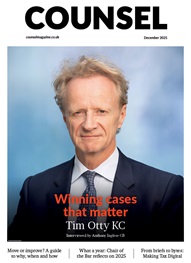*/
Male barristers still outnumber women by two to one, according to figures released by the Bar Standards Board.
The regulator’s annual Diversity at the Bar report showed that the profession is 63% male and 37% female and still has some way to go before it is fully representative of the public it serves.
Overall the percentage of women increased by 0.5%. While male QCs outnumber their female counterparts, the percentage of female Silks has risen from 13.7% in 2016 to 14.8% in 2017.
The percentage of barristers from an ethnic minority background rose to 12.7%, up by 0.5%, and the percentage in Silk rose by 0.8% to 7.2%.
The gender and ethnic diversity of pupil barristers is roughly in line with the population of England and Wales, with 51.7% of pupils being female and 16.1% being from an ethnic minority background.
The data showed that 12% of barristers went to private school, compared to 7% of the general population. But only 37% of barristers responded to that question, so the true number of those privately educated is likely to be higher.
BSB Director of Strategy and Policy, Ewen MacLeod, said the data showed ‘a steady improvement in gender and ethnic diversity at the Bar, especially in the increase in the number of female QCs’.
But he added: ‘We are conscious that there is more that needs to be done to improve diversity within the profession.’ He urged all barristers to complete the diversity data questions when renewing their practising certificates so that the regulator can act on accurate evidence to improve diversity.
Male barristers still outnumber women by two to one, according to figures released by the Bar Standards Board.
The regulator’s annual Diversity at the Bar report showed that the profession is 63% male and 37% female and still has some way to go before it is fully representative of the public it serves.
Overall the percentage of women increased by 0.5%. While male QCs outnumber their female counterparts, the percentage of female Silks has risen from 13.7% in 2016 to 14.8% in 2017.
The percentage of barristers from an ethnic minority background rose to 12.7%, up by 0.5%, and the percentage in Silk rose by 0.8% to 7.2%.
The gender and ethnic diversity of pupil barristers is roughly in line with the population of England and Wales, with 51.7% of pupils being female and 16.1% being from an ethnic minority background.
The data showed that 12% of barristers went to private school, compared to 7% of the general population. But only 37% of barristers responded to that question, so the true number of those privately educated is likely to be higher.
BSB Director of Strategy and Policy, Ewen MacLeod, said the data showed ‘a steady improvement in gender and ethnic diversity at the Bar, especially in the increase in the number of female QCs’.
But he added: ‘We are conscious that there is more that needs to be done to improve diversity within the profession.’ He urged all barristers to complete the diversity data questions when renewing their practising certificates so that the regulator can act on accurate evidence to improve diversity.


Chair of the Bar reflects on 2025
AlphaBiolabs has donated £500 to The Christie Charity through its Giving Back initiative, helping to support cancer care, treatment and research across Greater Manchester, Cheshire and further afield
Q&A with criminal barrister Nick Murphy, who moved to New Park Court Chambers on the North Eastern Circuit in search of a better work-life balance
Revolt Cycling in Holborn, London’s first sustainable fitness studio, invites barristers to join the revolution – turning pedal power into clean energy
Rachel Davenport, Co-founder and Director at AlphaBiolabs, reflects on how the company’s Giving Back ethos continues to make a difference to communities across the UK
By Marie Law, Director of Toxicology at AlphaBiolabs
Are you ready for the new way to do tax returns? David Southern KC explains the biggest change since HMRC launched self-assessment more than 30 years ago... and its impact on the Bar
Professor Dominic Regan and Seán Jones KC present their best buys for this holiday season
Oscar Davies shares their lessons learnt
Little has changed since Burns v Burns . Cohabiting couples deserve better than to be left on the blasted heath with the existing witch’s brew for another four decades, argues Christopher Stirling
Pointillism, radical politics and social conscience. Review by Stephen Cragg KC